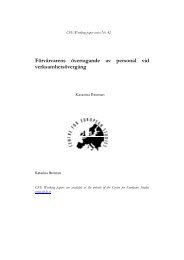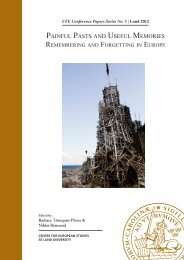MINNE OCH MANIPULATION - Centre for European Studies - Lunds ...
MINNE OCH MANIPULATION - Centre for European Studies - Lunds ...
MINNE OCH MANIPULATION - Centre for European Studies - Lunds ...
Create successful ePaper yourself
Turn your PDF publications into a flip-book with our unique Google optimized e-Paper software.
Empire, the fake “sources” speak of “the horrifying Selim I, a cruel oppressor of<br />
Christians who destroyed and converted to Islam Bulgaria, Albania and Bosnia”<br />
and who is accused of the assassination of the Patriarch of Constantinople. In<br />
sharp contrast with these falsifications, the “Annals of Universal Patriarchy”<br />
contain no report of an assassination of an Orthodox patriarch, neither in the XVth,<br />
nor XVIth century. The Austrian scholar Peter Schreiner is the publisher of Greek<br />
chronicles of the period, that describe Selim I’s personality and the events during<br />
his rule. The chronicles contain no data about <strong>for</strong>ceful Islamization campaigns in<br />
the Balkans from this period. Christian authors describe Selim I as “a courageous<br />
man of wise and fair judgment”. Furthermore: “He shows respect to Christians<br />
and especially to the Church of Christ. During his rule many churches were<br />
restored from ruins” (Chronicles 22 &79, quoted by M. Kiel).<br />
Despite such evidence, however, the most quoted source of the processes<br />
described above, is the narrative of the priest Methody Draginov. In 1984<br />
Bulgarian linguist Ilia Todorov was the first to prove the account to be an<br />
adulteration (Todorov 1984: 56-79). These findings, however, did not prevent<br />
Bulgarian scholars from including the narrative in textbooks and anthologies of<br />
Old-Bulgarian literature. Nor did it stop <strong>for</strong>eign experts in Bulgarian <strong>Studies</strong> from<br />
citing the priest’s narrative as highly illustrative evidence. Besides the facts that no<br />
one has ever seen the original of the “Narrative”, and that the language and style<br />
of the priest have nothing in common with the idiom and style of XVIIth century<br />
(as the narrative claims is the time of its composition), the author seems to have no<br />
idea that the villages he depicts as subject to mass and violent Islamization were<br />
already constituents of a large vakuf (the property of a Muslim religious<br />
foundation with a special status).<br />
Thus linguistic, historic and textological analyses of church annals and other<br />
sources show that most historic narrations of the “violent, full of terror and<br />
humiliation” Islamization of Bulgarian lands, specifically those referring to the<br />
conversion process in the Rhodopes Mountains, are hoaxes produced in the<br />
beginning or in the middle of the XIXth century by those who have “discovered”<br />
and published them. Historians have associated the ‘discovery’ of the “Narrative”<br />
with the launching of a series of nationalistic historical deceptions in Europe such<br />
as the Scottish “Ossian” and “Temora”, the Czech “Rukopis Kralevdvorski”, the<br />
Finnish “Kalevala”, and the French mystifications of Villmerque and Henry<br />
Martin (Kelbecheva 2009: 25-37). Other analysts have investigated the ideological<br />
causes and tasks of the author, as well as the special reasons <strong>for</strong> the conversion to<br />
Islam in the Rhodopes (Zhelizkova 1994: 105-111).<br />
The academic community, mainly the Bulgarian one, continues to argue<br />
about the authenticity of these documents, however, referring to the long-duration<br />
of historic memory and the interpretations made by authors of chronicles of later<br />
periods. (Gradeva 2012: 187-222). Decades long investigations by Bulgarian and<br />
Ottoman history experts have proved insufficient to overcome two-century long<br />
100




